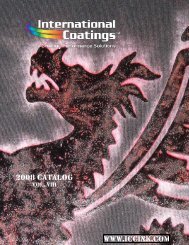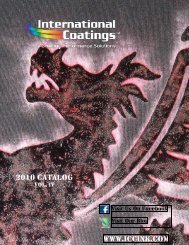2008 CATALOG WWW.ICCINK.COM
2008 CATALOG WWW.ICCINK.COM
2008 CATALOG WWW.ICCINK.COM
You also want an ePaper? Increase the reach of your titles
YUMPU automatically turns print PDFs into web optimized ePapers that Google loves.
Optilux Ultra Refl ective Ink Systems<br />
Optilux 505 Ultra Refl ective Plastisol is an easy to print, two-part, retro-refl ective ink that<br />
contains light-refl ecting microspheres. When a garment printed with Optilux 505 ink is<br />
exposed to a focused beam of light, such as that from a fl ashlight or an automobile headlight,<br />
it refl ects or returns light back to the light source.<br />
Optilux 505 Ultra Refl ective Plastisol can be used as a unique decorative tool to increase<br />
nighttime visibility of a printed design<br />
Optilux Application<br />
To obtain the best refl ective properties, Optilux 505 is recommended for use on open weaved fabrics.<br />
Optilux can also be used with very good to excellent results on some tightly woven nylon and polyester<br />
fabrics. Optilux 505 is not a low bleed product and is not recommended for use on bleeding fabrics.<br />
Nylon and Polyester Fabrics<br />
Print Optilux 505 ink through a 160 t/in to 230 t/in (63 t/cm to 90<br />
t/cm) Monofi lament screen. Use one fl ood stroke and one print stroke<br />
for best results. Two print strokes can be used for added opacity<br />
when printing through a 230-mesh t/in (90 t/cm).<br />
On tightly woven fabrics such as shell nylon, a fl ash cured underbase<br />
print of International Coatings’ 900 or 9000 Series nylon inks may be<br />
used to gain opacity, color and a smoother looking print. Printing<br />
Optilux 505 over an underbase may diminish the refl ective strength<br />
of the ink to a small degree but for some nylon or polyester fabrics,<br />
it is best to print over an underbase in order to obtain the cleanest<br />
print of the Optilux 505 ink. Printing Optilux 505 ink onto some<br />
tightly woven nylon or polyester materials without an underbase may<br />
leave the print looking pockmarked as the ink may not fl ow properly<br />
on some of these fabrics.<br />
Always test for adhesion when printing onto any tightly woven material<br />
such as shell nylon. Water- resistant or waterproof coatings on some<br />
nylon or polyester fabric may prevent proper adhesion of Optilux<br />
505.<br />
On some polyester materials, bleeding or dye migration may occur.<br />
These types of fabric should be tested prior to beginning any<br />
production of fi nished product. Bleeding or dye migration might not<br />
occur immediately, so longer term testing of the ink fi lm is strongly<br />
recommended when printing polyester or polyester blend fabrics.<br />
For more information about Optilux Ultra Refl ective Ink Systems<br />
www.vizrefl ectives.com/optilux or www.iccink.com/optilux<br />
Cotton and Cotton/Poly Blends Fabrics<br />
Print Optilux 505 ink through a 160 t/in to 230 t/in (63 t/cm to 90<br />
t/cm) Monofi lament screen. Use one fl ood stroke and one print stroke<br />
for best results. Two print strokes can be used for added opacity<br />
when printing through 230-mesh t/in (90 t/cm). Adding pigment to<br />
Optilux 505 ink will shade the ink slightly to a desired color, but<br />
adding too much pigment will diminish the refl ective properties of the<br />
ink.<br />
Note: It is not recommended to print Optilux 505 ink over an<br />
underbase print when printing on open weaved fabrics such as typical<br />
T-shirt type fabric.<br />
OptiluxInkSystem.indd 1 3/8/2006 13:07:06<br />
109




